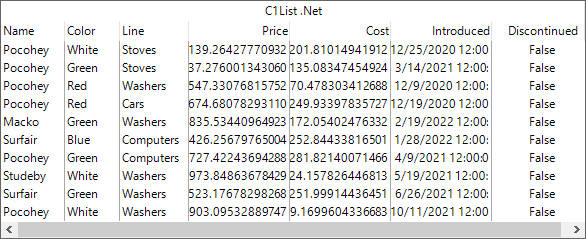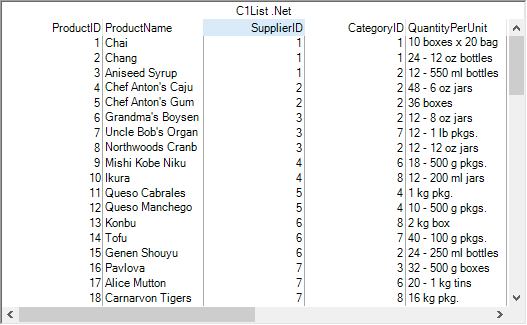- List for WinForms Overview
- Key Features
- Design-Time Support
- Quick Start
- Data Binding
- List Items
- Data Views
- Data Presentation
- Format
- Split Presentation
- Search
- Sort
- Navigation
- Scroll Bar
- Selection
- Virtualization
- Display Images
- ToolTips
- Bookmarks
- Export, Import, and Print
- Customization
- Styling and Appearance
- Integration with C1Combo
Quick Start
This quick start guides you through the steps of creating a simple List application. You begin by creating a Windows Forms App in Visual Studio, adding he List control to the Form and binding it to a data source.
.NET
Follow the given steps to create a simple List application in .NET Edition.

Set Up the Application
- Create a new Windows Forms App and set the project framework to .NET 6.0 using Configure your new project window.
- Install C1.Win.List package using NuGet Package Manager. The C1List control gets added to the Toolbox once the package gets installed.
- Drag and drop the List control from Toolbox onto the Form.
Bind List to a Data Source
Create a class named Product to be used as a data source.
public class Product { // Create a custom class Product static Random _rnd = new Random(); static string[] _names = "Macko|Surfair|Pocohey|Studeby".Split('|'); static string[] _lines = "Computers|Washers|Stoves|Cars".Split('|'); static string[] _colors = "Red|Green|Blue|White".Split('|'); public Product() { Name = _names[_rnd.Next() % _names.Length]; Line = _lines[_rnd.Next() % _lines.Length]; Color = _colors[_rnd.Next() % _colors.Length]; Price = 30 + _rnd.NextDouble() * 1000; Cost = 3 + _rnd.NextDouble() * 300; Discontinued = _rnd.NextDouble() < .2; Introduced = DateTime.Today.AddDays(_rnd.Next(-600, 0)); } public string Name { get; set; } public string Color { get; set; } public string Line { get; set; } public double Price { get; set; } public double Cost { get; set; } public DateTime Introduced { get; set; } public bool Discontinued { get; set; } }
Initialize a list of type Product.
// Initialises a List of type Product, where Product is a class type List<Product> _products = new List<Product>();
Initialize a for loop to add products using the Add method as shown in the following code.
// Initialize for loop and add products to the list for (int i = 0; i < 10; i++) { _products.Add(new Product()); }
Bind the List control to a data source by using DataSource property of the C1List class.
// Bind list with data c1List1.DataSource = _products;
Configure the List control
Add the following code to initialize and add the List control to the Form at runtime.
// Initialize the control
C1List c1list1 = new C1List();
// Add the control to form
this.Controls.Add(c1list1);
.NET Framework
Follow the given steps to create a simple List application in .NET Framework.

Set Up the Application
- Create a new Windows Forms App(.NET Framework) and set the project framework to .NET Framework 4.5.2 using Configure your new project window.
- Add the reference to C1.Win.List in your project.
- Drag and drop the List control from the Toolbox onto the form.
Observe: The List control gets added to the Form.
Bind List to a Data Source
There are two ways to bind data with the List control, either choose to bind at design time or through code at run time.
Binding at Design-time
- Select the List control and click the smart tag icon(
 ) to open the C1List Tasks smart tag panel in the design view.
) to open the C1List Tasks smart tag panel in the design view. - From the C1List Tasks smart tag panel, click the drop-down menu appearing against the Choose Data Source option.
- Click the Add Project Data Source link to open the Data Source Configuration Wizard window.
- Select Database and click the Next button on Choose a Data Source Type page.
- Select Dataset and click the Next button on the Choose a Database Model page.
- Click New Connection to open the Add Connection dialog from the Choose Your Data Connection page.
- Click the Change... button against the DataSource field to open the Change Data Source dialog.
- Select Microsoft Access Database File and click OK to return to the Add Connection dialog.
- Click the Browse button against the Database file name field and navigate to the database file. Provide the User name and Password, if required to connect to the database file. This example uses the C1NWind.mdb file located at the following location, by default, on your system: \Documents\ComponentOne Samples\Common.
- Click Test Connection to make sure that you have successfully connected to the database or server and click OK.
- Click OK again to close the Add Connection dialog box.
- Click Next to continue. A dialog box will appear asking if you would like to add the data file to your project and modify the connection string. Choose the appropriate option as per your requirement.
- Save the connection string in the application configuration file by checking the Yes, save the connection as box, and enter a name.
- Click Next to switch to the Choose Your Database Objects page.
- Choose database objects from the Data Source Configuration Wizard window that you want in your dataset. In this example, we are selecting the Products table for data binding.
- Click Finish to complete the data binding.
The above steps add a dataset, and a connection string to your project. With this, the following code gets generated automatically to fill the dataset:
// TODO: This line of code loads data into the 'c1NWindDataSet1.Products' table. You can move, or remove it, as needed.
this.productsTableAdapter.Fill(this.c1NWindDataSet1.Products);
Binding through Code
To bind the List control through code, follow the given steps.
Create a method named GetConnectionString to return the connection string.
static string GetConnectionString() { string path = Environment.GetFolderPath(Environment.SpecialFolder.Personal) + @"\ComponentOne Samples\Common"; string conn = @"provider=microsoft.jet.oledb.4.0;data source={0}\c1nwind.mdb;"; return string.Format(conn, path); }Subscribe to the Form_Load event and add the following code to the Form1_Load event handler. In this code, we create a string type object to fetch the connection string by calling the GetConnectionString() method and then populate the List control using DataSource property of the C1List class.
// bind list to a data source string conn = GetConnectionString(); OleDbDataAdapter da = new OleDbDataAdapter("select * from products", conn); DataTable dt = new DataTable("Products"); //fills the data table da.Fill(dt); //populate list control using DataSource property c1List1.DataSource = dt;
Configure the List control
Add the following code to initialize and add the List control to the Form at runtime.
// Initialize the control
C1List c1list1 = new C1List();
// Add the control to form
this.Controls.Add(c1list1);


